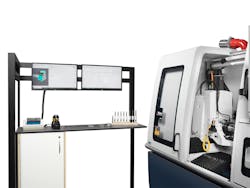Radio frequency identification (RFID) was once one of the most widely discussed technologies for use in various manufacturing industry applications, from assembly to shipping. Though radio frequency technologies have taken a bit of a backseat to other identification and positioning technologies as prices for those other technologies have dropped, radio frequency tech has not disappeared. In fact, it’s seeing a bit of a resurgence, as evidenced by Humatics application of RF microlocation in its in-motion assembly technology.
As further evidence of RF tech’s continued use, ANCA, a CNC grinding machine supplier, has released its FX-RFID automated regrinding system that can process mixed tool batches in a lights-out operation. According to ANCA, its FX-RFID allows for tools of various types and diameters and from different orders to be dynamically loaded, rather than having to be pre-sorted by diameter or customer as typically necessary in mixed batches.
ANCA’s FX-RFID is targeted at machine tool service providers, such as Australia’s CarbitoolTool, which manufactures carbide tools for the woodworking, cabinetry, joinery, furniture, timber and panel industries. Carbitool is the first user of ANCA’s FX-RFID system in Australia. A video explaining Carbitool’s use of FX-RFID can be found below.
ANCA’s FX-RFID system comes with an extension to the machine canopy and a Fanuc 200iD robot. Dynamic loading of the FX is enabled by the following system components: Dynamic Tool Group Manager—this programming station is used to prepare the tools for regrinding. Using ANCA’s RFID workflow, tools can be loaded into the machine without having to pre-program individual pallet pockets. ANCA says the RFID and tool carrier can be placed anywhere on the RFID pallet top, with the tool holder's RFID code used to locate the assigned program.
- RFID assembly (using Sick reader and interchange station).
- Bench-mounted scanning station.
- A Schunk collet adapter and collet rack to hold up to six bayonet collets.
- RFID pallet top with 88 tool capacity and RFID tool carriers.
A key capability of the FX-RFID is its ability to run lights out for hours at a time. Referencing this capability, ANCA notes: While some resharpening services aim to run their machines unattended for a brief period with only a small mixed batch of tools…ANCA's RFID solution enables them to run their machines unattended for several hours, or even overnight. When the machine picks up the tool with the RFID tool holder, it scans the RFID code and automatically retrieves the corresponding grinding program, sets all grinding parameters, and loads the correct wheel pack. If a collet change is needed, the machine executes it automatically.”
The FX-RFID system uses two pallets and a pallet top with a maximum capacity of 88 tools. According to Andreas Sommer, ANCA product manager, “Regrinding an endmill or similar cutting tool takes an average of five to six minutes. With a rate of 10 tools per hour, it's easy to estimate the potential for unattended lights-out regrinding to increase machine utilization and productivity.”
ANCA adds that, during the FX-RFID’s running schedule, tools can be added, removed, or rearranged within the pallet. The job will terminate when an empty pocket is detected, indicating the end of the pallet.


